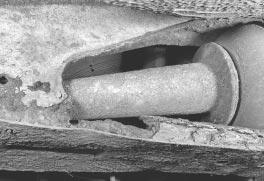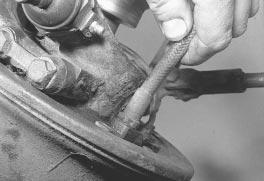
4 minute read
Section
movement disappears or becomes less severe, then the wheel hub bearings in the swivel hub are at fault. Any perceptible movement at all indicates wear in the hub bearings, and they should be renewed as described in Chapter 10. Swivel hub balljoints
7 Wear of the swivel hub balljoints is fairly common on Minis and will be quite obvious on inspection because the whole swivel hub will appear to move in relation to the suspension arms as the wheel is rocked. If this is the case, the balljoints should be adjusted, or if badly worn, renewed; these procedures are contained in Chapter 10. Suspension arm mountings
8 Check for wear of the lower arm inner mounting bushes where the arm is bolted to the subframe. If the bushes are worn, the arm will appear to move in and out as the wheel is rocked. 9 The upper arm inner roller bearings cannot be inspected without partially dismantling the suspension because the rubber cone spring or displacer unit holds the arm in tension and any wear will not be evident. It can be removed for closer inspection if required as described in Chapter 10; however, wear of the upper arm and its bearings is uncommon. 10 With the brakes still firmly applied, try to rotate the wheel back and forth. If any movement is now felt, examine the tie-bar between the lower suspension arm and subframe for wear or deterioration of the rubber bushes. Rear suspension
11 To check the rear suspension for wear, chock the front wheels then jack up the rear of the car and support it on axle stands (see “Jacking and vehicle support”). 12 Wear of the rear suspension components can often be felt when driving the car as a tendency for the rear of the vehicle to wander over uneven road surfaces or when cornering. To isolate the worn components, grasp the roadwheel at the 12 o’clock and 6 o’clock positions and try to rock it. If any movement is felt, it is likely to be in one of the following areas: Hub bearings
13 Continue rocking the wheel while an assistant depresses the footbrake. If the movement disappears or becomes less pronounced, then the bearings in the rear hub are at fault. The bearings should be renewed if there is any appreciable movement whatsoever.
Wear in the rear hub bearings can often be confirmed by slowly turning the wheel with your hand on the tyre. Worn bearings usually exhibit a roughness which can be felt as the wheel is turned.
Radius arm bearings
14 With the footbrake still applied, continue rocking the wheel and observe the front of the radius arm. If it can be seen to move appreciably up and down, then wear has taken place in the roller or plain bearing in the radius arm, or on the pivot shaft. If this is the case, the radius arm should be removed for overhaul as described in Chapter 10.
6 Underbody and fuel/brake line check 1
1 With the vehicle raised and supported on axle stands (see “Jacking and vehicle support”), or over an inspection pit, thoroughly inspect the underbody and wheel arches for signs of damage and corrosion. In particular, examine the bottom of the side sills, and any concealed areas where mud can collect. Where corrosion and rust is evident, press and tap firmly on the panel with a screwdriver, and check for any serious corrosion which would necessitate repairs. If the panel is not seriously corroded, clean away the rust, and apply a new coating of underseal. Refer to Chapter 11 for more details of body repairs. 2 At the same time, inspect the treated lower body panels for stone damage and general condition. 3 Examine the subframes carefully, particularly the side members of the rear subframe. Corrosion here is a common occurrence on Minis, particularly older models, and is one of the main causes of MOT test failure on these cars (see illustration). Where corrosion has reached an advanced stage, renewal of the subframe is the only satisfactory cure. 4 Inspect all of the fuel and brake lines on the underbody for damage, rust, corrosion and leakage. Also make sure that they are correctly supported in their clips. The battery positive cable which runs under the car from front to rear is a common problem area as it is prone to damage or chafing if not properly routed or secured. 5 Inspect the flexible brake hoses in the vicinity of the backplates or front calipers, where they are subjected to most movement (see illustration). Bend them between the fingers (but do not actually bend them double, or the casing may be damaged) and check that this does not reveal previously hidden cracks, cuts or splits.
7 Exhaust system check 1
1 With the engine cold (at least three hours after the vehicle has been driven), check the complete exhaust system, from its starting point at the engine to the end of the tailpipe. Ideally, this should be done on a hoist, where unrestricted access is available; if a hoist is not available, raise and support the vehicle on axle stands (see “Jacking and vehicle support”).

6.3 Advanced state of corrosion on rear subframe side member 6.5 Inspect the flexible brake hoses in the vicinity of the backplates






